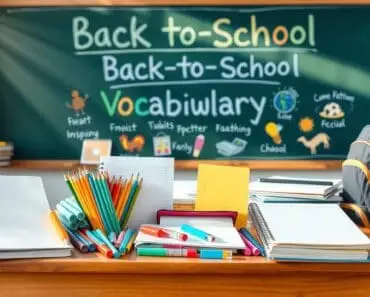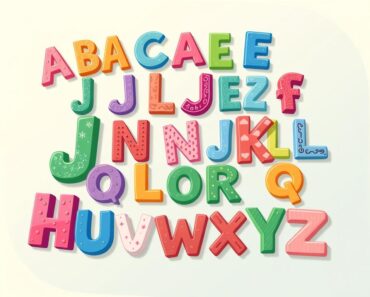Have you ever wondered how a single word can change a simple sentence into a rich tapestry of images and feelings?
Descriptive adjectives are the hidden gems of language. They make writing clearer and more creative. In this lesson, we’ll see how these words can bring your sentences to life.
If you want to learn English adjectives or improve your writing, knowing descriptive words is key. Let’s explore the world of descriptive adjectives together. We’ll discover their magic and how to use them in everyday language.

Key Takeaways
- Descriptive adjectives give detailed info about nouns, making your writing clearer and more vivid.
- Using different adjectives helps avoid boring and fake writing styles.
- Learning about descriptive adjectives can really boost your communication skills.
- Descriptive adjectives come in different forms, like positive, comparative, and superlative.
- It’s important to know the difference between various adjectives, like limiting, demonstrative, and possessive ones.
- Using descriptive words in writing can help show characters, settings, and scenes in creative stories.
Introduction to Descriptive Adjectives
Descriptive adjectives add depth and texture to English. They turn simple statements into rich, sensory experiences. This makes storytelling and communication more vivid. Whether in conversations or writing, knowing how to use them is key.
Most adjectives are descriptive, offering many ways to describe people, places, and things. Words like *angry* and *young* show how adjectives qualify nouns by expressing their quality. Using them well makes your expressions clearer and more appealing.
Understanding descriptive adjectives is crucial. They can be used before nouns, pronouns, or as complements after linking verbs. The right order is important, with limiting adjectives before descriptive ones. You can also make comparative and superlative forms to compare items, adding more depth.
Knowing the correct order of adjectives is vital. For example, when describing the same noun or pronoun with multiple adjectives, there’s a specific order. Learning about English adjectives in context helps you use them naturally and effectively.
| Adjective Type | Example |
|---|---|
| Descriptive Adjective | Lovely |
| Comparative Adjective | More beautiful |
| Superlative Adjective | Most interesting |
What Are Descriptive Adjectives?
Descriptive adjectives add depth and clarity to our language. They are key to making our words more vivid and meaningful.
Definition and Importance
Descriptive adjectives describe the qualities of nouns. They make our language more engaging by creating clear images. For example, “beautiful,” “angry,” and “brave” are simple adjectives that spark emotions.
Other examples include compound adjectives like “baby-faced” and “long-lasting.” These add depth to our descriptions. Adjectives help us understand and connect with what we read.
Examples of Descriptive Adjectives
Here’s a list of descriptive adjectives to help you understand:
| Category | Example |
|---|---|
| Simple Descriptive Adjectives | Beautiful, Angry, Brave |
| Comparative Descriptive Adjectives | Taller, Quicker, Cheaper |
| Compound Descriptive Adjectives | Baby-faced, Red-blooded, Long-lasting |
| Color Descriptive Adjectives | Blue, Green, Scarlet |
| Opinion Descriptive Adjectives | Delightful, Disgusting, Wonderful |
| Size Descriptive Adjectives | Big, Tiny, Enormous |
Knowing these categories helps you choose the right adjective. They also follow rules, like coming before the noun and matching its gender and number. Learning about these adjectives makes your writing more vivid and accurate.
Common Descriptive Adjectives You Should Know
Learning 100 descriptive adjectives is key for clear communication. This section lists adjectives from ‘A’ to ‘Z’. It’s a great tool for those looking to improve their descriptive language skills. The list is organized by type, like physical, emotional, and opinion adjectives, to meet different needs.
Knowing adjective descriptive words boosts your writing. These adjectives help you describe people, things, and situations better. Here’s a start with some types:
- Emotional Adjectives: joy, sadness, excitement, calmness, anxiety
- Sensory Adjectives: aromatic, creamy, loud, soft, vibrant
- Evaluative Adjectives: brilliant, incompetent, exceptional, mediocre
The frequently asked questions section offers more on adjectives. It includes examples and tips for using them.
Most Popular Adjectives List: Using a variety of adjectives makes your writing more engaging. Here’s a look at different types and why they matter:
| Category | Examples | Percentage |
|---|---|---|
| Positive/Neutral Adjectives | able, clear, easy, good | 75% |
| Negative Adjectives | bad, hard, weird | 20% |
| Context-Dependent Adjectives | busy, late, low | 5% |
Adjectives for personal traits, looks, and qualities are included. They help you describe people well in different situations. Using these 100 adjectives can make your stories vivid and engaging.
Try out different adjectives for job descriptions to create specific feelings or meanings. Mastering these adjectives will improve your writing and talking skills.
How to Use Descriptive Adjectives in Writing
Learning to use descriptive adjectives is key to making your writing vivid and appealing. This part focuses on using these words well in character and setting descriptions. Using them right can bring characters and settings to life, making your stories more immersive and fun to read.
Descriptive Adjectives in Characters Description
Choosing the right adjectives for character descriptions is crucial. They help readers see your characters in a new light. For example, calling someone “meticulous” tells us a lot about their way of thinking.
Here are some tips for using adjectives well:
- Choose specific words, nouns, and verbs over vague ones.
- Focus on details that engage the reader’s senses.
- Use figurative language like similes and metaphors.
- Explore the five senses with sense charts and examples.
Setting the Scene with Descriptive Adjectives
Setting the scene is also vital, and adjectives are key here. They help create the mood and atmosphere you want. For instance, “serene” or “chaotic” sets a clear mood right away.
Here are some stats on teaching descriptive writing:
- Lessons are made for different levels: Elementary, Intermediate, and Advanced.
- Activities last from 10 to 55 minutes, depending on the task.
- Tasks include dialogues, reading, and writing exercises.
- Focus on adjectives and present simple tense to improve vocabulary and grammar.
- Interactive tasks, for individuals and groups, boost creativity and critical thinking.
By mastering the use of descriptive adjectives, writers can make their stories more engaging and relatable.
English Vocabulary Lesson 3: Descriptive Adjectives for People and Things
In this vocabulary lesson for descriptive adjectives, learners explore a wide range of adjectives. They focus on both positive and negative traits. This lesson uses 458 adjectives to help learners understand and use them well.
Students start by looking at adjectives for people and adjectives for things. They learn from examples like:
- Adjectives starting with ‘S’: 79 examples such as “sincere” and “spectacular”.
- Adjectives starting with ‘M’: 19 examples like “meticulous” and “magnificent”.
- Adjectives starting with ‘C’: 29 examples including “charismatic” and “charming”.
- Adjectives starting with ‘B’: 23 examples such as “brilliant” and “bold”.
They also learn about positive and negative traits. There are 85 positive adjectives and 24 negative ones. The lesson includes fun exercises to help learners practice.
| Activity Type | Purpose |
|---|---|
| Positive/Negative Adjective Sorting | Help students identify and categorize adjectives. |
| Picture Matching | Match pictures with appropriate adjectives to reinforce learning. |
| Personality Surveys | Enhance understanding by describing oneself and others with adjectives. |
| Audio Listening/Speaking Exercises | Engage auditory skills and improve pronunciation of descriptive adjectives. |
Audio and picture exercises make learning fun and engaging. Students practice using adjectives in sentences. This helps them understand and use descriptive language better.
There are also PDF resources available. They include exercises on adjectives for people, things, cities, and life. These exercises help learners become more confident in using descriptive adjectives.
Descriptive Adjectives for Personality Traits
Understanding the power of descriptive adjectives for personality is key in creating vivid character profiles. Whether for a literary piece or everyday conversation, using a variety of adjectives makes your descriptions better.

Using friendly can show someone is warm and easy to talk to. Terms like hard-working and dedicated show someone’s commitment. Kindness shows a person’s caring side.
Adjectives like lazy and rude can show negative traits. A neat person is organized, and someone polite shows respect.
Words like smart and wise show someone’s intelligence. Creativity makes someone stand out. Being brave or fearless shows courage.
People seen as selfish or shy might not be sociable. But those who are energetic and enthusiastic are lively. Observant people notice details, and modest people are humble.
The table below shows positive and negative adjectives for personality traits clearly:
| Positive Traits | Negative Traits |
|---|---|
| Adaptable | Lazy |
| Adventurous | Rude |
| Affectionate | Selfish |
| Polite | Shy |
| Neat | Quiet |
| Bright | Popular |
| Compassionate | — |
| Brave | — |
| Smart | — |
| Wise | — |
| Honest | — |
| Loyal | — |
Using a mix of positive and negative adjectives can create a full picture of someone’s personality. This makes descriptions more engaging and accurate.
Descriptive Adjectives to Describe Objects
Descriptive adjectives are key for adding detailed, vivid descriptions of objects. They help create clear, engaging images in the minds of readers or listeners. Using adjectives to describe things, like products or foods, greatly affects how they are seen.
Adjectives for Product Descriptions
Choosing the right words for adjectives for product description can sway customer choices. It makes products more appealing. For example, a smartphone might be called “sleek,” “innovative,” and “user-friendly.” A piece of furniture could be “sturdy,” “elegant,” and “spacious.”
- Sleek – Smooth, stylish appearance
- Innovative – Featuring new ideas or methods
- Sturdy – Strong and robust
- Elegant – Graceful and stylish in appearance or manner
- Spacious – Having ample space
Adjectives for Food Descriptions
Using adjectives food description can make descriptions more appealing. Words like “crispy,” “juicy,” “aromatic,” “savory,” and “refreshing” bring out specific tastes, textures, and smells. This makes food more enticing.
- Crispy – Having a firm, dry, and brittle surface
- Juicy – Full of juice; succulent
- Aromatic – Having a pleasant and distinctive smell
- Savory – Pleasant taste, usually not sweet
- Refreshing – Giving a fresh and revitalizing feeling
By using these adjectives to describe things like products and food, writers and marketers can craft compelling stories. These stories connect with their audience. The right use of descriptive adjectives makes communication clearer and enhances the consumer experience.
| Adjective Type | Example | Context |
|---|---|---|
| Product | Sleek | Used to describe electronic gadgets |
| Product | Sturdy | Describing furniture’s robustness |
| Food | Juicy | Used for fruits or meats |
| Food | Aromatic | Describing fragrant dishes |
Descriptive Adjectives in Different Languages
Descriptive adjectives are key in making our words rich and diverse. In Spanish, there’s a wide range of words that describe feelings and traits well. Learning these adjectives helps us share our thoughts more clearly, building stronger bonds.
Children start learning about descriptive adjectives early. For example:
- Toddlers learn words like small, big, and messy.
- By preschool, they get to know more detailed words like polite, clever, and interesting.
Learning descriptive adjectives in various languages is fun with games and daily word exercises. In class, activities like listening and drawing help students remember new words. For instance, using weather words like stormy and misty makes learning more real.
Here’s a table showing some English and Spanish descriptive adjectives. It shows how each language can express a wide range of ideas:
| English | Spanish |
|---|---|
| Small | Pequeño |
| Big | Grande |
| Messy | Desordenado |
| Polite | Cortés |
| Fearful | Temeroso |
| Interesting | Interesante |
| Gentle | Amable |
| Stormy | Tormentoso |
Knowing descriptive adjectives in different languages helps us communicate better in many settings. Exploring Spanish descriptive adjectives, for example, opens up a world of cultural insights and language skills.
Exercises to Practice Descriptive Adjectives
Doing exercises with descriptive adjectives can really help you get better at using them. Let’s explore some ways to improve your skills through practice sentences and quizzes.

Practice Sentences with Descriptive Adjectives
Using descriptive adjectives in different situations helps you understand them better. Here are some sentences to start with:
- Mark is an incredibly ambitious person who always sets big goals for himself.
- The cheerful child made everyone happy, even on the saddest days.
- The creative artist always finds new ways to share her feelings through her work.
- Because of his enthusiastic nature, Jake quickly became popular with his friends.
- Her patience with kids is amazing; she never gets angry.
- My best friend is very loyal and will always support me.
- Even when things get tough, she stays punctual and reliable.
- The self-confident speaker really impressed the audience with her bold presence.
- Sometimes, he can be very stubborn, refusing to change his mind, even when it makes sense.
- Her thoughtfulness makes sure everyone feels loved and important.
Descriptive Adjectives Quizzes
Quizzes are a fun way to check how well you know descriptive adjectives. Try these quizzes to make learning more fun.
- Matching Game: Match adjectives like kind, rude, friendly, and lazy with sentences that fit them.
- Fill in the Blanks: Choose the right descriptive adjectives to describe different situations.
- Listening Exercise: Listen to descriptions of people and pick the best adjectives for them.
- Partner Description Activity: Use many adjectives to describe a partner, and see if they can guess who it is.
These activities not only help you remember more words but also make you better at using them. By doing these exercises often, you’ll get better at using different adjectives in your writing and talking.
Downloadable Resources: Descriptive Adjectives PDF
Boost your learning with our detailed descriptive adjectives PDF for students and teachers. It’s packed with adjectives for all levels, making it a great tool for building vocabulary.
Teachers can use the printable list as a visual aid in class. It makes adding new words to the curriculum easy. With the descriptive adjectives PDF, students can improve their writing by adding more detail and depth.
Our resources come in two formats: PDF and Google Slides. This lets users pick the best option for their needs.
| Resource | Description | Format |
|---|---|---|
| Printable Adjectives List | Ideal for classroom use, featuring adjectives categorized by emotions, traits, and characteristics. | PDF, Google Slides |
| Interactive Activity | An engaging activity that helps students use adjectives effectively in sentences. | Google Slides |
| SCOOT! Game | A fun and educational game to reinforce the use of descriptive adjectives. | |
| Poster Pack | Visually appealing posters that highlight different types of adjectives. |
We worked with Teach Starter’s Kendall Britnell to create adjective lists for various grades. Our lists range from simple emotional words for young students to complex traits for older ones. They’re designed to spark creativity and improve language skills.
If you’re a teacher wanting to make your lessons more engaging or a student looking to improve your writing, our download descriptive adjectives resources are here to help. These tools make learning new words fun and easy.
Tips for Choosing the Best Descriptive Adjectives
Good writing starts with picking the right words. Here are five tips to help you choose the best descriptive adjectives for your writing:
1. Use Adjectives in Moderation: It’s tempting to add lots of interesting words. But, too many can make your writing hard to read.
2. Choose Adjectives Based on Context: The setting matters a lot. Pick words that fit the mood you want to create. For example, ‘melancholy’ is better for sad scenes than ‘joyful.’
3. Experiment with Different Adjectives: Try out different words. This helps you find the perfect one to describe what you mean.
4. Use Descriptive Adjectives to Capture Imagination: Pick words that make readers imagine. Words like ‘well-built,’ ‘curvy,’ or ‘graceful’ add depth to your writing.
5. Simplify Sentences When Necessary: Sometimes, fewer words are better. If a sentence is too long, make it simpler. This makes your writing clearer.
Adjectives are powerful tools for writers. Whether you’re in online English classes or just improving, these tips will help make your writing more engaging.
Conclusion
We’ve looked into how important descriptive adjectives are in English. They help us improve our English skills. Our course made learning fun for kids and beginners.
The lesson plan was full of fun activities like drawing and board games. These made learning exciting and easy to remember. You can print out the materials for use in school.
We covered a wide range of positive adjectives for feelings, personality, and looks. Words like “adventurous” and “elegant” were highlighted. We also talked about synonyms for “good” like “amazing” and “wonderful.”
Learning to use descriptive adjectives makes our language richer. It helps us describe things in a more detailed and colorful way. As you keep working on your English, using descriptive adjectives will make your writing and talking better.
FAQ
What are descriptive adjectives?
Descriptive adjectives are words that describe the qualities of nouns. They help us understand more about the noun they modify. This makes writing clearer and more creative.
Can you provide some examples of descriptive adjectives?
Sure! Words like “vibrant,” “melancholic,” “serene,” “robust,” and “fragile” are examples. There are many more.
How do descriptive adjectives enhance writing?
They make writing vivid and detailed. They help create images in the reader’s mind. This makes writing more engaging and dynamic.
What are some common descriptive adjectives?
Common ones include “happy,” “sad,” “tall,” “short,” “beautiful,” “ugly,” “excited,” and “calm.”
How can descriptive adjectives be used effectively in character descriptions?
Use them to highlight specific traits and behaviors. This makes characters feel real and relatable.
What role do descriptive adjectives play in setting a scene?
They paint a picture of the environment. They provide context and atmosphere. This immerses readers in the setting.
Which adjectives are useful for describing personality traits?
Useful ones include “charismatic,” “introverted,” “ambitious,” “generous,” “stubborn,” and “empathetic.”
What are some descriptive adjectives for product descriptions?
For products, consider “sleek,” “durable,” “innovative,” “compact,” and “luxurious.”
Can you give examples of descriptive adjectives used in food descriptions?
For food, think of “savory,” “crisp,” “tender,” “delectable,” and “spicy.”
Are descriptive adjectives the same across different languages?
The idea of descriptive adjectives is the same everywhere. But the words and meanings can differ. For example, “feliz” in Spanish means “happy” in English.
How can I practice using descriptive adjectives?
Practice with exercises and quizzes. These help you learn and use new vocabulary.
Where can I find a downloadable list of descriptive adjectives?
Look for a PDF list on educational websites or language learning platforms. It’s a great study resource.
What tips can help in choosing the best descriptive adjectives?
Choose words that highlight the qualities you want to show. Avoid repeating yourself. Make sure your choices make your writing clear and engaging.





